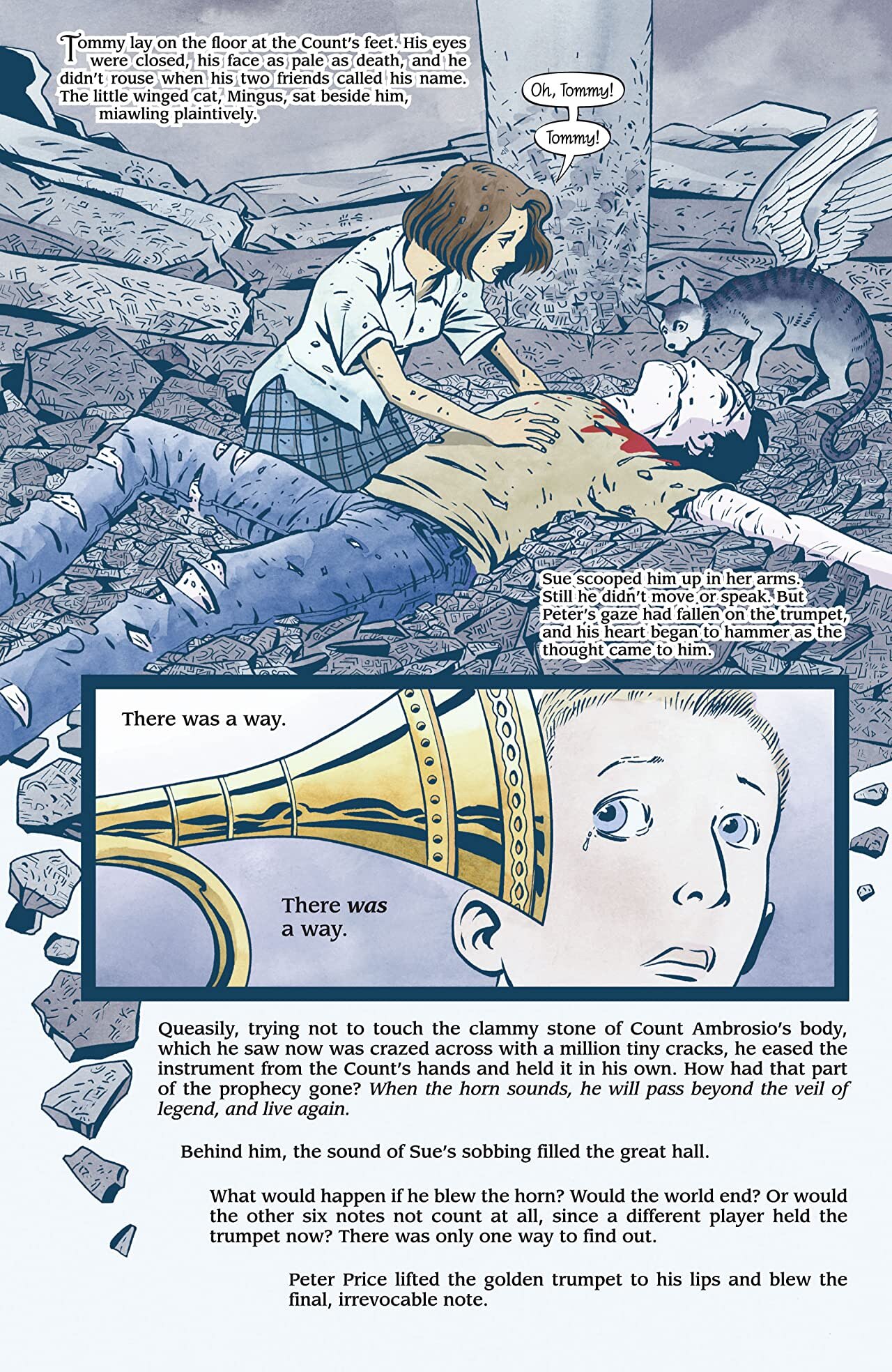Vertigo Comics' THE UNWRITTEN...and the Power of Stories
By Taylor Pechter — A Hopi proverb reads, "Those who tell stories rule the world." This power of literary magnitude is brought to bear in The Unwritten from writer Mike Carey and artist Peter Gross, with additional inks by Vince Locke and Ryan Kelly, colors by Chris Chuckery, and letters by Todd Klein.
This book, along with its sequel series The Unwritten: Apocalypse, was published by Vertigo between 2010 and 2015. It follows the journey of Tom Taylor (a character and not the comics writer), who is a man in his father's shadow, notable fantasy writer Wilson Taylor. Through Tom's journey, he has to come to terms with that shadow and follow his own hero's path. In the series, Carey examines and deconstructs the hero's journey through aspects of the series, the corruption of belief through the mysterious Cabal, the never-ending perception of stories in the mythical Leviathan, and the crossing of the final threshold at the end of the journey in Apocalypse.
In today’s piece, it’s the structure of that hero’s journey I’d like to discuss.
Vertigo Comics’ The Unwritten: Tommy Taylor and the Hero's Journey
In 1949, professor Joseph Campbell published the book The Hero of A Thousand Faces. In said book, Campbell details the 17-step journey of the prototypical hero. In The Unwritten, Carey flips this base on its head with the main character, Tom Taylor, and his literary counterpart, boy wizard Tommy Taylor. Using juxtaposition, he simultaneously weaves narratives. At the start of Tom's journey, he is on a book tour for the next book in the fictional Tommy Taylor series, Tommy Taylor and The Golden Trumpet. It is here where his call to adventure beckons.
Lizzie Hexam, whose name refers to the Charles Dickens novel Our Mutual Friend, inquires him, "Who are you?". This question rattles Tom, as he has to wonder if he is the man or just the creation. As he descends from the podium, Lizzie follows him back to his hotel room. Here, she becomes his first supernatural aid, another step in the ladder, and another analogous character, this time to Tommy's female companion, Sue Sparrow.
Near the end of the initial arc, we meet the third and final supernatural aid, freelance journalist Richie Savoy. Initially, Savoy is just a person following the Tom Taylor story tangentially, but he is soon embroiled in it once he is beset upon by Count Ambrosio, Tommy's vampiric adversary. As he slowly turns, Tom is confronted with his first threshold. It is to be at Villa Diodati, the mansion of his reclusive father. It is there that a congregation of horror writers has gathered to discuss the facets of their genre.
This is short-lived, however, as the house is attacked by the mysterious Pullman (and we’ll get to Pullman later). Framed for the massacre, he explores the annals of the house and discovers one of its mysteries, that being a crystal doorknob and a map, marked with locations of famous literary works.
It is here where Carey starts exploring the dichotomy of fiction and reality. As Tom enters the worlds of myths and legends, he is faced with even more trials and tribulations. From the battlefields of Ronceveax with Roland to the Pequod crew with Ahab, it is shown through Tom's point of view the importance of these stories not only to the modern mythology but to his own monomyth. It is on the Pequod's crew where he first confronts the mythical Leviathan, in the shape of the massive whale Moby Dick.
The book will explore the importance of Leviathan. It will serve as the main McGuffin and the manifestation of a step along the hero's journey, the "belly of the whale." It is where Tom has to reconcile with both his journey and the journey of his fictional counterpart.
As time goes on, Tom has to travel the hell and back, in his own personal Orpheus and Eurydice, his inner conflict with his father comes to a head. This moment is where Lizzie's question from the beginning of the series comes back around. Who is Tom Taylor? Is he his father's son, or just the manifestation of a writer's creation brought to life? Was his life preordained, or can the cycle be broken? As the main series comes to a close, we see Tom as he blows the Golden Trumpet, singling the end of his journey and his rebirth. As this coming apocalypse begins to beckon, our hero — as per the journey structure — has to rise like a phoenix and start anew.
The Cabal and Corruption of Belief
Little is known of the mysterious Cabal known as The Unwritten. As the namesake of the series, it denotes intrigue, but is is also intimidating. Supposedly going back centuries, their origins are unknown. They would like to keep it that way. While little of their history is known at the beginning of the series, their motives are clear. As a constant obstacle in Tom's journey, they also see the full power that stories have on the world. While Tom is out to preserve stories, The Cabal is out to corrupt. This motive is seen through the two principal members in the series: the imposing character of Pullman and the puppet master pulling the strings, Madame Rausch.
First seen primarily as the operation's muscle, Pullman killed the Cabal leader, Callander, near the series's start. From there, he rises to become a leader, his main goal, put an end to Tom Taylor and capture Leviathan. This conflict comes to a crashing head in the story’s climactic arc, The War of Words.
As Tommy and his companions lead a head-on assault on the group, we are supplied with the Cabal's history through ".5" issues. In these issues, we see why there is a little history about the Cabal. With characters such as Pullman, their purpose is only supplied within the service of the hero. Since he can't be tied down by anything singular, however, his presence is that of a ghost, a mysterious man playing an everlasting role.
Leviathan is the key. With the whale's corruption and death, his story can finally end, and he can be at peace. However, if the whale dies, so do stories and their connection to the zeitgeist. Without that personal connection, the stories will lose purpose and will ultimately be forgotten. During the War, the Cabal sets up "The Grid," a network of people trying to rewrite the story as it is happening. This action is not as easy as it seems since the wheels are in motion. A rewrite, while it could be beneficial from their standpoint, could also tear the story asunder.
Though Pullman takes the more active role in the fight, the eerie puppet master Madame Rausch takes a more duplicitous role behind the scenes. She serves the purpose of exposing the machinations of Wilson Taylor on his son's life. In many ways, he is controlling the strings to move the story forward. After all, he wrote the Tommy Taylor books. He already knows the stories as they are written. He knows the ending from the beginning as any good writer should. After the Cabal's dissolution after their defeat in the War or Words and Pullman's apparent "death," Rausch retreats to her dwelling. As Leviathan's wound deepens and her life grows short, she has one last heart to heart with Tom and the gang, coming to terms with her fate and role in the story.
Leviathan: The Nexus of Stories
Where do all the stories meet? How do they keep themselves from being forgotten or corrupted? The answer lies within Leviathan. A reference to the mythological beast of the same name, Leviathan, takes shape as Moby Dick, and his belly is the nexus point. Where stories live and where they die. If Leviathan dies, the stories sie with him. At first a mystery to both sides; it soon becomes a dire situation in the War of Words' aftermath. A mortal wound as befallen the beast, as was the action of Pullman, before his demise. With this wound, the outside world feels the ripple effects. Not only are fiction and reality merging, but it causing the stories to get infected. This infection creates what is called a "canker."
We saw an example of this near the start of the series with Jüd Süss. A story of a Jewish banker who became an advisor to a nobleman. This story, however, was twisted into antisemitic propaganda by the Nazis and thus is remembered as such. These cankers are seen as aberrations, and this is what plays into Pullman's hands. Pullman, in a way, is the ultimate canker. A being whose one purpose is to infect and corrupt. With Leviathan's death, he can finally be forgotten, not just an everlasting pawn in its game. As Leviathan slowly withers, the horn is blown, which signals the Apocalypse.
Apocalypse: Crossing the Final Threshold
The end of the world. Cankers run rampant as chaos reign. While Tom's physical ended with a blow of the Golden Trumpet, his metaphysical journey has yet to conclude. With friendships broken and family's dissolved, one final confrontation with Pullman awaits. After his supposed death, he has now ascended to a higher form of literary being. It will take the power of both his physical and "literary" self to help subdue the threat. That is the final threshold that needs to be crossed. He has reconciled with his fate, and that acceptance marks the end of the series.
The Art
Providing the art is frequent collaborator Peter Gross. Having built up a relationship with their time on Lucifer, they are completely simpatico with The Unwritten's execution. His clean and textured linework helps give a storybook quality to the book. While it is primarily self-inked, specific sections are inked by different people, namely by Vince Locke and Ryan Kelly. While Gross's inks are delicate and precise, Locke's are more on the scratchy side. This decision adds a great dichotomy to the art.
The main star here, however, is the panel layouts and how they shift throughout the series. At the start, they are standard grid layouts. While some breakage happens here and there, it is not until the chaos starts where they change. As fiction starts bleeding into reality, the frenetic layouts perfectly encapsulate this entropy. Rounding out the team is colorist Chris Chuckery and letterer Todd Klein. Chuckey's deft use of colors helps define each arc. From the deep sepia tone of Jud Süß to the weary greens in Leviathan and the melancholic blues in Orpheus in the Underworld. Todd Klein's fantastic use of fonts and bubble placement helps give an even pace to the action. Lastly, not to be ignored are the covers by Yuko Shimizu. The illustrative nature of the covers helps portray the majesty, brutality, and sadness seen in fantasy.
In conclusion, The Unwritten is Carey and Gross's magnum opus. It is a resonating story about fiction versus reality, the importance of stories, and the deconstruction of narrative and monomyth. Whether it was Tom's own personal hero's journey, the quest of corruption with The Cabal, the exploration of the nexus of stories with Leviathan, or crossing in the final threshold in Apocalypse, the parts come together to form a love letter to literature and fantasy. When all is said and done, stories are the only thing worth dying for.
Read more writing about comics storytelling from Taylor Pechter.
Taylor Pechter is a passionate comic book fan and nerd. Find him on Twitter @TheInspecter.













